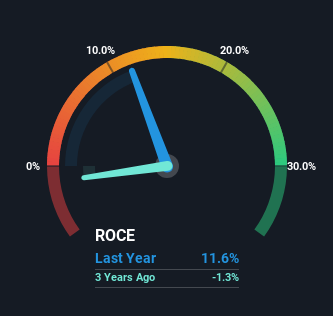We Like These Underlying Return On Capital Trends At Murphy Oil (NYSE:MUR)
Murphy Oil Corporation MUR | 33.90 | +0.21% |
There are a few key trends to look for if we want to identify the next multi-bagger. Amongst other things, we'll want to see two things; firstly, a growing return on capital employed (ROCE) and secondly, an expansion in the company's amount of capital employed. Ultimately, this demonstrates that it's a business that is reinvesting profits at increasing rates of return. Speaking of which, we noticed some great changes in Murphy Oil's (NYSE:MUR) returns on capital, so let's have a look.
Understanding Return On Capital Employed (ROCE)
If you haven't worked with ROCE before, it measures the 'return' (pre-tax profit) a company generates from capital employed in its business. Analysts use this formula to calculate it for Murphy Oil:
Return on Capital Employed = Earnings Before Interest and Tax (EBIT) ÷ (Total Assets - Current Liabilities)
0.12 = US$1.0b ÷ (US$9.8b - US$847m) (Based on the trailing twelve months to December 2023).
Thus, Murphy Oil has an ROCE of 12%. In absolute terms, that's a pretty normal return, and it's somewhat close to the Oil and Gas industry average of 13%.
View our latest analysis for Murphy Oil

Above you can see how the current ROCE for Murphy Oil compares to its prior returns on capital, but there's only so much you can tell from the past. If you'd like, you can check out the forecasts from the analysts covering Murphy Oil for free.
So How Is Murphy Oil's ROCE Trending?
Murphy Oil has not disappointed with their ROCE growth. More specifically, while the company has kept capital employed relatively flat over the last five years, the ROCE has climbed 482% in that same time. So our take on this is that the business has increased efficiencies to generate these higher returns, all the while not needing to make any additional investments. On that front, things are looking good so it's worth exploring what management has said about growth plans going forward.
The Bottom Line
To sum it up, Murphy Oil is collecting higher returns from the same amount of capital, and that's impressive. Since the stock has returned a solid 92% to shareholders over the last five years, it's fair to say investors are beginning to recognize these changes. So given the stock has proven it has promising trends, it's worth researching the company further to see if these trends are likely to persist.
If you'd like to know about the risks facing Murphy Oil, we've discovered 2 warning signs that you should be aware of.
While Murphy Oil may not currently earn the highest returns, we've compiled a list of companies that currently earn more than 25% return on equity. Check out this free list here.
This article by Simply Wall St is general in nature. We provide commentary based on historical data and analyst forecasts only using an unbiased methodology and our articles are not intended to be financial advice. It does not constitute a recommendation to buy or sell any stock, and does not take account of your objectives, or your financial situation. We aim to bring you long-term focused analysis driven by fundamental data. Note that our analysis may not factor in the latest price-sensitive company announcements or qualitative material. Simply Wall St has no position in any stocks mentioned.




